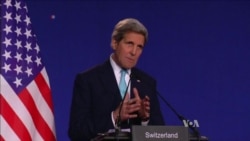Iranian and international negotiators resumed talks in Vienna this week as part of efforts to finalize an agreement on the future of Tehran’s nuclear program by the end of June.
They are working from a list of agreed parameters, but important differences remain, as U.S. Secretary of State John Kerry acknowledged when he announced the framework accord April 2 in Lausanne, Switzerland.
Kerry said the foreign ministers of six countries deputized by the United Nations Security Council had reached a “political understanding” with Iran’s foreign minister, which Kerry said would be “a solid foundation for the good deal that we are seeking.”
The United States published a four-page list of points it said had been agreed upon.
Kerry also said the negotiators had “agreed on the most challenging and overarching issues,” while acknowledging that “there are a number of technical decisions that need to be made and there are still policy decisions that have to be made.”
As two years of talk head toward a final deadline of June 30, some of the most difficult issues were yet to be decided. These are believed to include the exact schedule for relief from international sanctions against Iran; the precise access rules for international inspectors’ visits to Iran’s nuclear sites; and the extent to which Iran will provide information to the International Atomic Energy Agency about its past nuclear weapons program.
Still, nuclear proliferation expert Mark Fitzpatrick of the Britain's International Institute for Strategic Studies was impressed.
“The political understanding that was agreed to on the 2nd of April, went much further than I thought it would,” he told VOA. “The fact that they overcame most of the issues leaves me thinking that, yes, by June 30, they will be able to seal the deal.”
Terms still in dispute
Iran, however, did not sign on to the American list.
"The decision we took today is very important because it forms the basis for a full agreement,” Foreign Minister Mohammad Javad Zarif said.
He repeated in broad terms many of the points in the American document, but in subsequent days Iranian leaders appeared to dispute some key items.
Iran’s supreme leader, Ayatollah Ali Khamenei, said all sanctions must be removed immediately and that there will be no inspections of military facilities.
Fitzpatrick says that would be a problem.
“Ruling it out, I think, opens too many avenues for Iran to be able to clandestinely produce nuclear weapons,” he said. “That would violate the whole principle of the deal, that all of Iran’s paths to nuclear weapons have to be foreclosed.”
Still, there is considerable hope among experts that the disagreements can be worked out in the coming months to ensure Iran’s nuclear program is purely peaceful, as it claims.
“Iranian Foreign Minister Javad Zarif has not said anything that contradicts the U.S. fact sheet,” said Kelsey Davenport of the Washington-based Arms Control Association.
“The details that he released in Tehran coincide with the basic principles that the United States laid down in the White House fact sheet,” she added. “I think that’s very important.
With parameters announced in Lausanne having laid the groundwork for completing a final deal by June 30, right now, Davenport said, negotiators must work out only "smaller details” of the final agreement.
Still, that may not be as easy as it sounds, with Secretary Kerry’s statement that there are still both “technical” and “policy” decisions to be made. He and other ministers are expected to rejoin as the process continues.
The negotiators worked two days past their last deadline at the end of March, and experts believe there will be another series of late night, past-deadline meetings about nine weeks from now.







